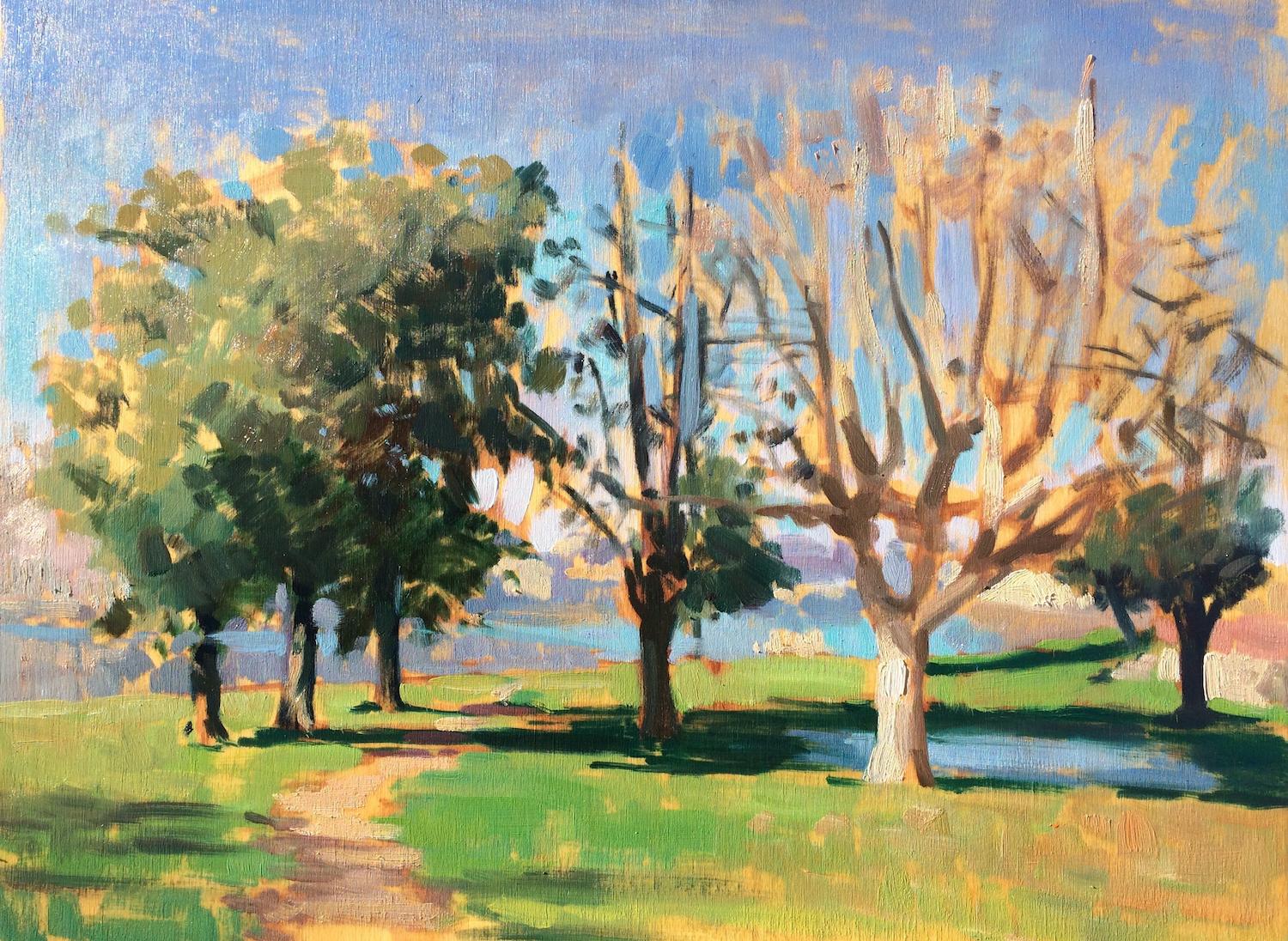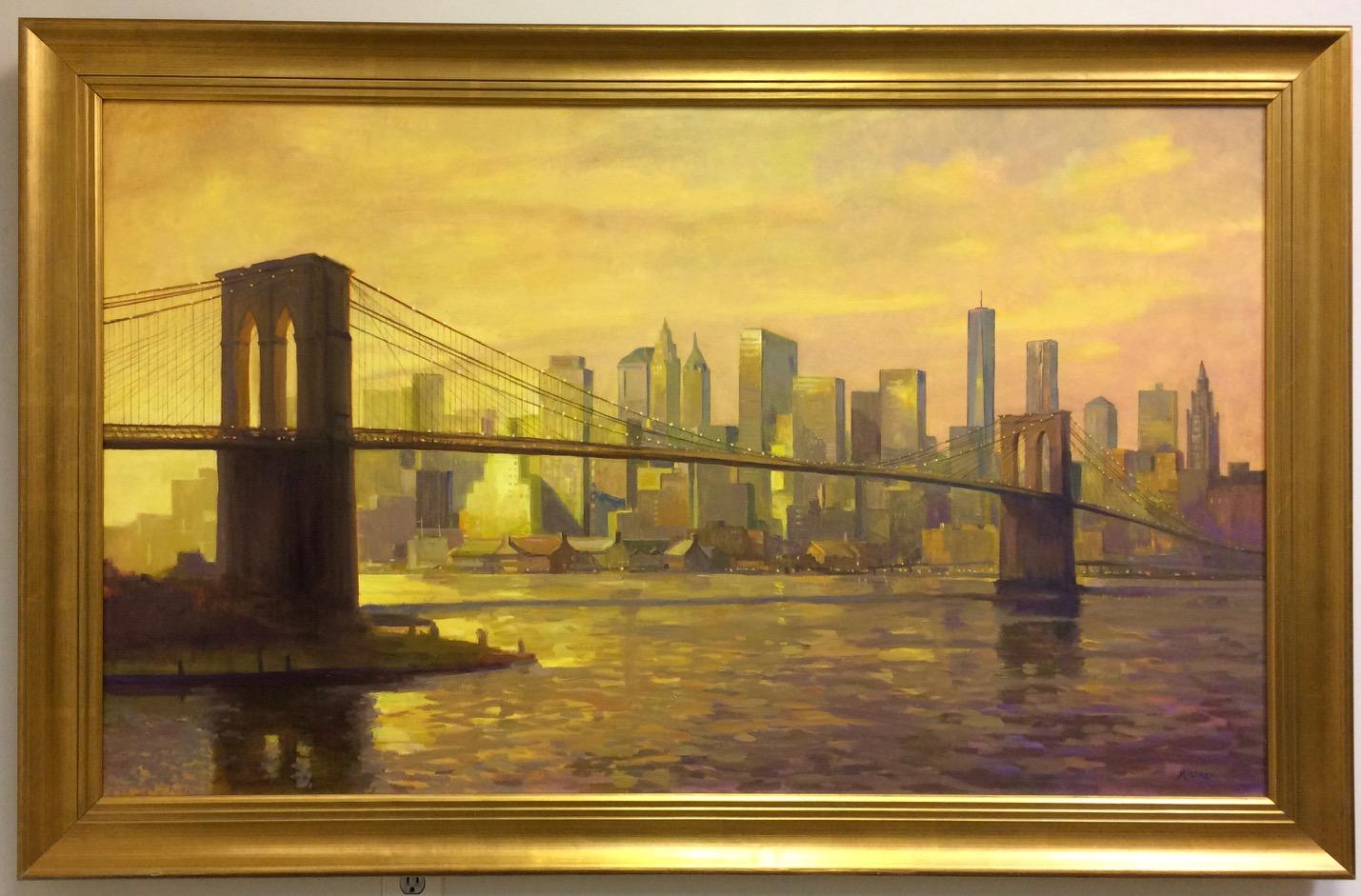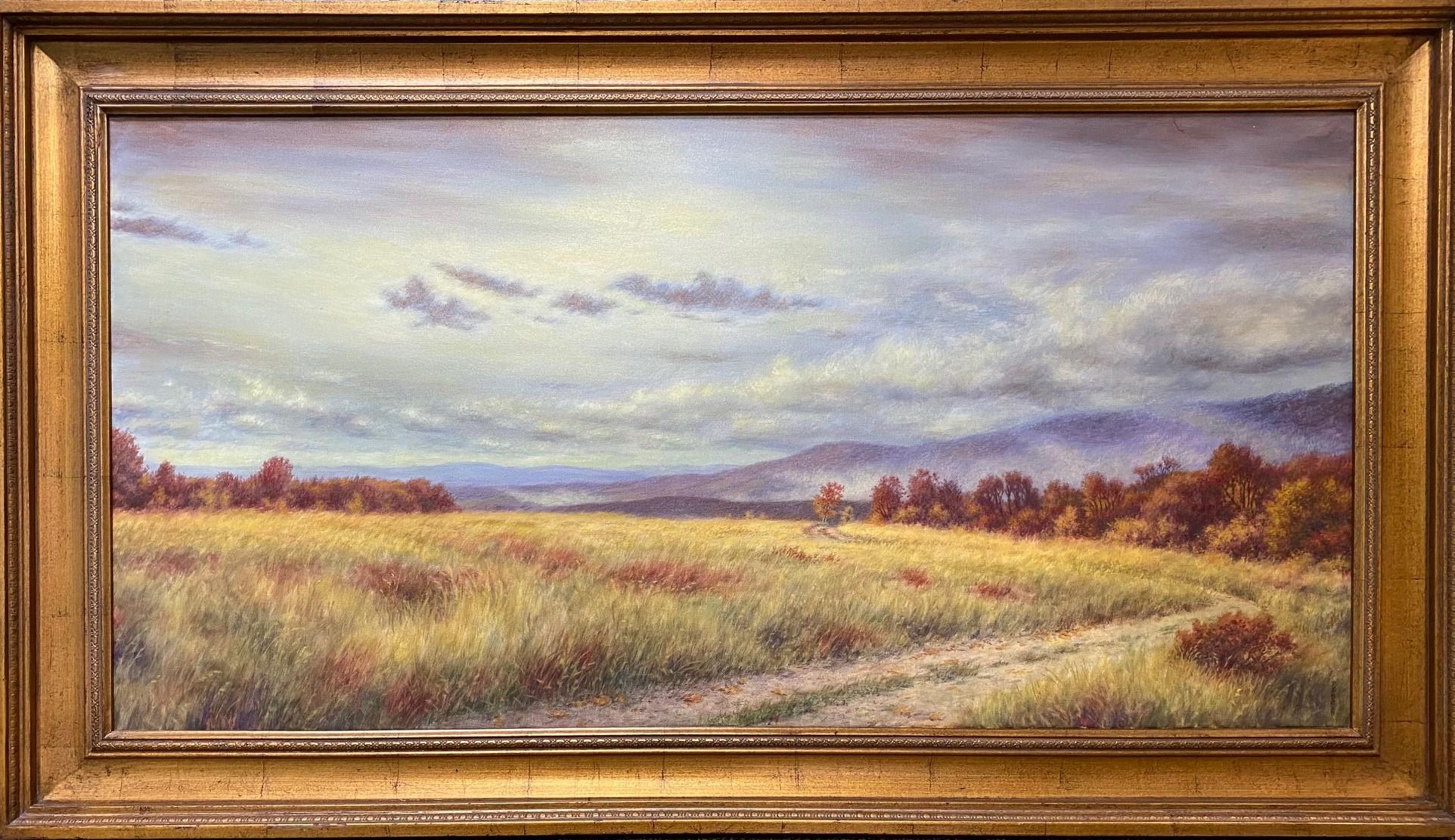Items Similar to Crossing the Common French 19thC art figurative windmill landscape oil painting
Want more images or videos?
Request additional images or videos from the seller
1 of 12
Georges MichelCrossing the Common French 19thC art figurative windmill landscape oil paintingCirca 1835
Circa 1835
About the Item
This superb French 19th century figurative landscape oil painting with excellent provenance is by noted French artist Georges Michel. Painted circa 1835 it is entitled verso Crossing the Common. The painting depicts an expansive flat landscape with a windmill and trees to the right. In the foreground a mother, in a red dress and child are walking along a path towards the windmill and away from the viewer and artist. The foreground is bathed in light under a blustery looking sky. Michel always painted within a small area limited to the surroundings of Paris. His preferred locations were Montmartre, where he was inspired by the famous windmills, the plains of Saint-Denis, the villages ofVaugirard, Grenelle, Montsouris, Romainville and Le Pré-Saint-Gervais so this is likely to be one of those locations, perhaps the plains of Sant-Denis. Michel developed a very personal vision, in which light and treatment of the sky and space became his principal concern. His paintings became more unified compositionally, with vast expanses of landscape and wide perspectives under stormy skies. The windmills are often the sole accents punctuating the compositions. After 1830 he was at the peak of his talent. His style became even more lyrical and visionary, his brushstrokes broader and his paint thicker. This painting is an excellent example of all of the above.
Provenance: The collection of James S. Forbes Esq. His sale, May 23 1874, Christie's lot 119
Bought by Thomas Agnew & Sons for George Salting Esq.Sale,
Christie's, Sir Thomas Devitt, 16 May 1924, lot 139
Derrick Warden Milligan (d. 1974)
Thence by family descent
Various labels verso.
Condition. Oil on paper laid on canvas, image size 22 inches by 18 inches, in good condition.
Frame. Housed in an ornate gilt frame, 30 inches by 26 inches, in good condition.
Georges Michel (1763-1843). Michel was born in in Paris. He came from a humble background, his father being an employee at the market of Les Halles. At an early age, Michel worked on a farm in the Saint-Denis region, north of Paris, where he first developed his interest in the countryside. In 1775, he was apprenticed to a mediocre history painter, but he preferred to sketch outdoors. A colonel of the Hussars engaged him in his regiment, garrisoned in Normandy, and arranged for him to take further lessons. Michel remained there for more than a year, after which he returned to Paris. Later in 1798, Michel left for Switzerland, and also visited Germany. The art dealer Jean-Baptiste-Pierre Le Brun authorized Michel to copy the seventeenth century Dutch paintings that were in his shop, and was, in a way, very responsible for the artist’s further artistic development. In 1791 Michel debuted at the Salon, where he continued to exhibit regularly. Nevertheless, critics ignored Michel, considering his works too similar to those of the Dutch masters. Around 1800, Michel was employed by the Musée du Louvre to restore their Flemish and Dutch paintings, and it was in this capacity that he developed a true understanding of the technique of his predecessors. In 1808, he decided to set up a studio and give lessons, but he stopped teaching the following year. In 1813 he opened a shop adjacent to his studio and sold furniture and paintings. He exhibited for the last time at the Salon of 1814. After the death in 1820 of the last surviving of his eight children, he left Paris to stay for one year in Picardy. After his return, he began to live a reclusive life and gradually withdrew from the art world. Because of his self-imposed artistic isolation, Michel had to rely solely on the patronage of the Baron d’Ivry, who purchased almost his entire output until 1830, when the two men had a falling out over political differences. Michel always painted within a small area limited to the surroundings of Paris. He commented that ‘whoever cannot paint within an area of four leagues is but an unskilled artist who seeks the mandrake and will only ever find a void.” His preferred locations were Montmartre, where he was inspired by the famous windmills, the plains of Saint-Denis, the villages ofVaugirard, Grenelle, Montsouris, Romainville and Le Pré-Saint-Gervais. His small plein air studies were often drawings heightened with watercolor wash, which were then used as preliminaries for paintings worked up in the studio. His career can be divided into three phases. The first, until circa 1808, includes the period of his collaboration with Jean-Louis Demarne and Jacques-François Swebach, artists who often executed the staffage of his landscapes. Later he developed a more personal vision, in which light and treatment of the sky and space became his principal concern. His paintings became more unified compositionally, with vast expanses of landscape and wide perspectives under stormy skies. The windmills are often the sole accents punctuating the compositions. After 1830 he was at the peak of his talent. His style became even more lyrical and visionary, his brushstrokes broader and his paint thicker. He reinforced the dramatic tension by accentuating the heaviness of the skies and the contrasts of light and dark. Michel had little interest in fame, and with the exception of a few early paintings, his works are unsigned. Michel meant that the quality of the painting should speak to the beholder, and not the signature. He never achieved success during his lifetime and in 1841, two years before his death, the contents of his studio, consisting of more than 1000 studies and 2000 drawings, were put up at auction. The Barbizon painter Charles Jacques acquired several of his works, and other artists from this group, like Jules Dupré, were much inspired by Michel. His importance is more as a precursor of the works of the Barbizon school, while his own oeuvre has not yet been given the full attention that it deserves.
Selected Museum Collections:
Amiens; Baltimore, Walters Art Museum; Bayeux; Beauvais, Musée départemental de l’Oise; Béziers; Bordeaux, Musée des Beaux-Arts; Boston, Museum of Fine Arts; Brest; Buffalo, NY, Albright-Knox Art Gallery; Carpentras; Chicago, Art Institute of Chicago; Cleveland Museum of Art; Dijon, Musée Magnin; Hanover; The Hague, Museum Mesdag; Lille, Musée des Beaux-Arts; London, Courtauld Institute; London, National Gallery; Lyon, Musée des Beaux-Arts; Madrid, Thyssen-bornemisza Museum; Nantes; New York, Metropolitan Museum of Art; Paris, Musée du Louvre; Pontoise; Portland Art Museum; Rennes, Musée des Beaux-Arts; St. Petersburg, Hermitage; State College, PA, Palmer Museum of Art; Strasbourg; Valenciennes, Musée des Beaux-Arts..
- Creator:Georges Michel (1763-1843, French)
- Creation Year:Circa 1835
- Dimensions:Height: 26 in (66.04 cm)Width: 30 in (76.2 cm)Depth: 2 in (5.08 cm)
- Medium:
- Movement & Style:
- Period:
- Condition:
- Gallery Location:London, GB
- Reference Number:1stDibs: LU853114375122
About the Seller
5.0
Platinum Seller
These expertly vetted sellers are 1stDibs' most experienced sellers and are rated highest by our customers.
1stDibs seller since 2018
402 sales on 1stDibs
Typical response time: 1 hour
- ShippingRetrieving quote...Ships From: London, United Kingdom
- Return PolicyA return for this item may be initiated within 14 days of delivery.
More From This SellerView All
- Summer Afternoon Firth of Clyde - British exh figurative seascape oil paintingLocated in London, GBThis lovely Scottish exhibited seascape oil painting is by noted Scottish artist Patrick Downie. It was painted in 1914 and exhibited at the Glasgow Institute of Fine art that year e...Category
1910s Impressionist Landscape Paintings
MaterialsOil
- The Anastasia - Scottish Impressionist 1911 Norwegian marine art oil paintingBy James Campbell NobleLocated in London, GBA fine oil on canvas by Scottish listed artist John Campbell Noble RSA. Painted circa 1911 it is a fine example of Scottish Impressionism and depicts a river/marine landscape with ...Category
1910s Impressionist Landscape Paintings
MaterialsOil
- Seascape with Boats Storm Coming - Scottish 19thC exh impressionist oil paintingBy Joseph HendersonLocated in London, GBThis dramatic Scottish Impressionist 19th century oil painting is by noted Scottish artist Joseph Henderson. Painted in 1876 it was exhibited at the Royal Scottish Academy the same y...Category
1870s Impressionist Landscape Paintings
MaterialsOil
- Stirling River Landscape Scotland - Scottish Impressionist 1910 art oil paintingBy Joseph Morris HendersonLocated in London, GBThis lovely Scottish Stirlingshire Impressionist landscape is by noted artist Joseph Morris Henderson. Painted circa 1910 the composition is a river landscape with the river in the foreground and cows in the fields beyond. In the distance one can see some dwellings and hills beyond those, all beneath a summers sky. The impressionistic brushwork and colouring are just lovely. This is an excellent large example of Henderson's work and of Scottish landscape art...Category
1910s Impressionist Landscape Paintings
MaterialsOil
- Reclining Nude - Industrial Scene Verso - Scottish 1940's portrait oil paintingLocated in London, GBThis interesting British 1940's oil painting is attributed to Harry Jefferson Barnes. Barnes trained at the Slade School of Art and later went on to become Director of the Glasgow Sc...Category
1940s Impressionist Nude Paintings
MaterialsOil
- Landscape with Sheep - Scottish 19th century Kirkcudbright art oil paintingLocated in London, GBThis lovely Scottish Victorian Impressionist oil painting is by noted Kirkcudbright artist William Mouncey. Painted circa 1890 it is a landscape of a shepherd and his flock under tre...Category
1890s Impressionist Landscape Paintings
MaterialsOil
You May Also Like
- Boats on a River - Mid 20th Century French Impressionist Landscape Oil PaintingLocated in Sevenoaks, GBA beautiful mid 20th century French impressionist oil on canvas depicting moored boats on a river. Highly atmospheric original French oil on c...Category
Mid-20th Century Impressionist Landscape Paintings
MaterialsCanvas, Oil
- Banks of the ArnoBy Amy FlorenceLocated in Sag Harbor, NYAn oil painting of trees along the Arno River in Italy. Bright greens make up the foreground, and a cloudless blue sky makes up the background. One tree stands bare, without leaves. ...Category
21st Century and Contemporary Impressionist Landscape Paintings
MaterialsOil
- Sunset at the Brooklyn Bridge, NYC original 36x60 impressionist landscapeBy Leonard MizerekLocated in Spring Lake, NJBrooklyn eclipses Manhattan, as the glow of the sunset softens the Manhattan skyline and causes the Brooklyn Bridge to sparkle. The multitude of soft, layered colors, subtle lighting...Category
21st Century and Contemporary Impressionist Landscape Paintings
MaterialsOil
- Fields of Gold, original 24x48 contemporary impressionist autumn landscapeBy Barry DeBaunLocated in Spring Lake, NJThere are fields of gold where fanciful rolling hills abound, and mystical clouds carry you off into dreams where the twilight twinkles! This contemporary impressionist autumn landscape is reminiscent of a magic carpet ride empowered with the sheer pleasure of gliding off into a peaceful state of nirvana! Artist Barry DeBaun...Category
21st Century and Contemporary Impressionist Landscape Paintings
MaterialsOil
- "Figures in Venice by the Canal" Impressionist Scene Oil Painting on Wood BoardBy Luigi CaglianiLocated in New York, NYA whimsical oil painting depicting Figures near the canal in Italy. As an Italian Impressionist artist, most of Cagliani's works were produced in the first half of the 20th Century. ...Category
Early 20th Century Impressionist Landscape Paintings
MaterialsWood Panel, Oil
- Lilies, Original oil Painting, Ready to HangBy Vahe YeremyanLocated in Granada Hills, CAArtist: Vahe Yeremyan Work: Original Oil Painting, Handmade Artwork, One of a Kind Medium: Oil on Canvas Year: 2021 Style: Impressionism, Subject: Lilies, Size: 18" x 14" x 0.8''...Category
2010s Impressionist Landscape Paintings
MaterialsCanvas, Oil
Recently Viewed
View AllMore Ways To Browse
Antique Art Sale
Paris Art Dealers
Antique Painting Unsigned
Antique Shop Drawing
Vision Antique
Antique Oil Painting Red
Antique Frames Lot
Swiss Style Paper Art
Musee De Louvre
Antique Studio Light
Art Auction Sale
Saint George Painting
Ornate Framed Landscape Art
Montmartre Oil Painting
Art Four Antiques
Montmartre Frame
Oil Paintings Of Montmartre
The Windmill




